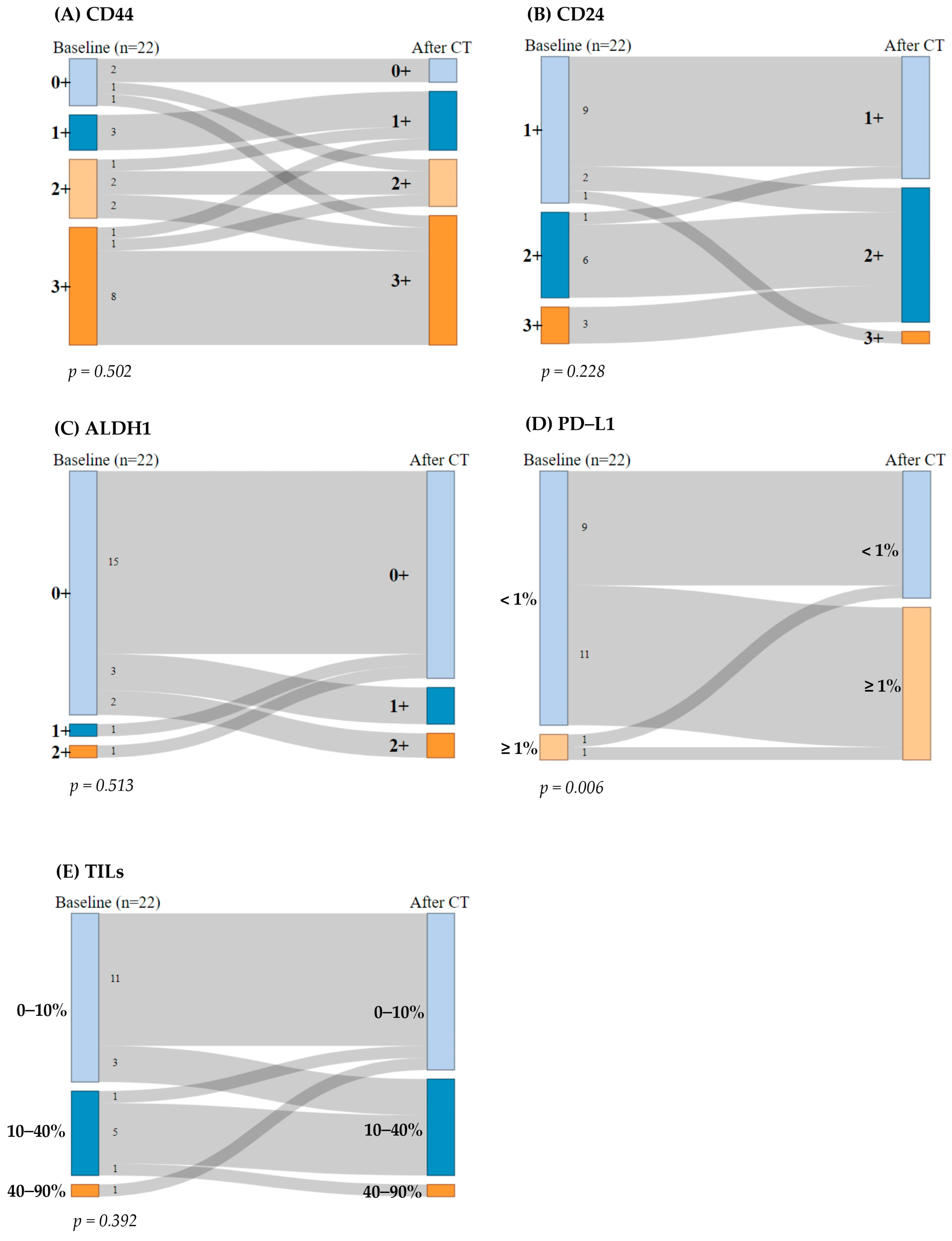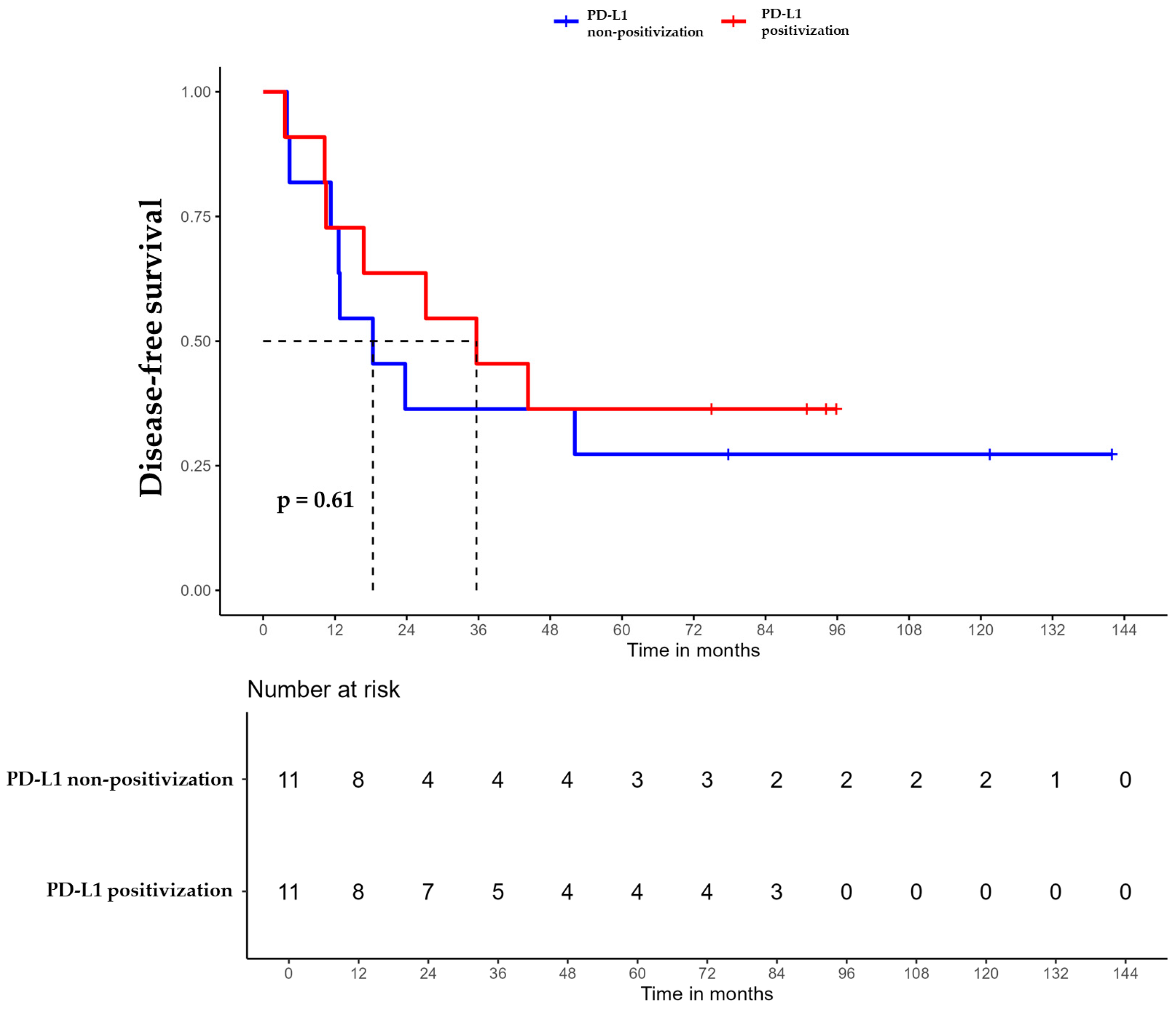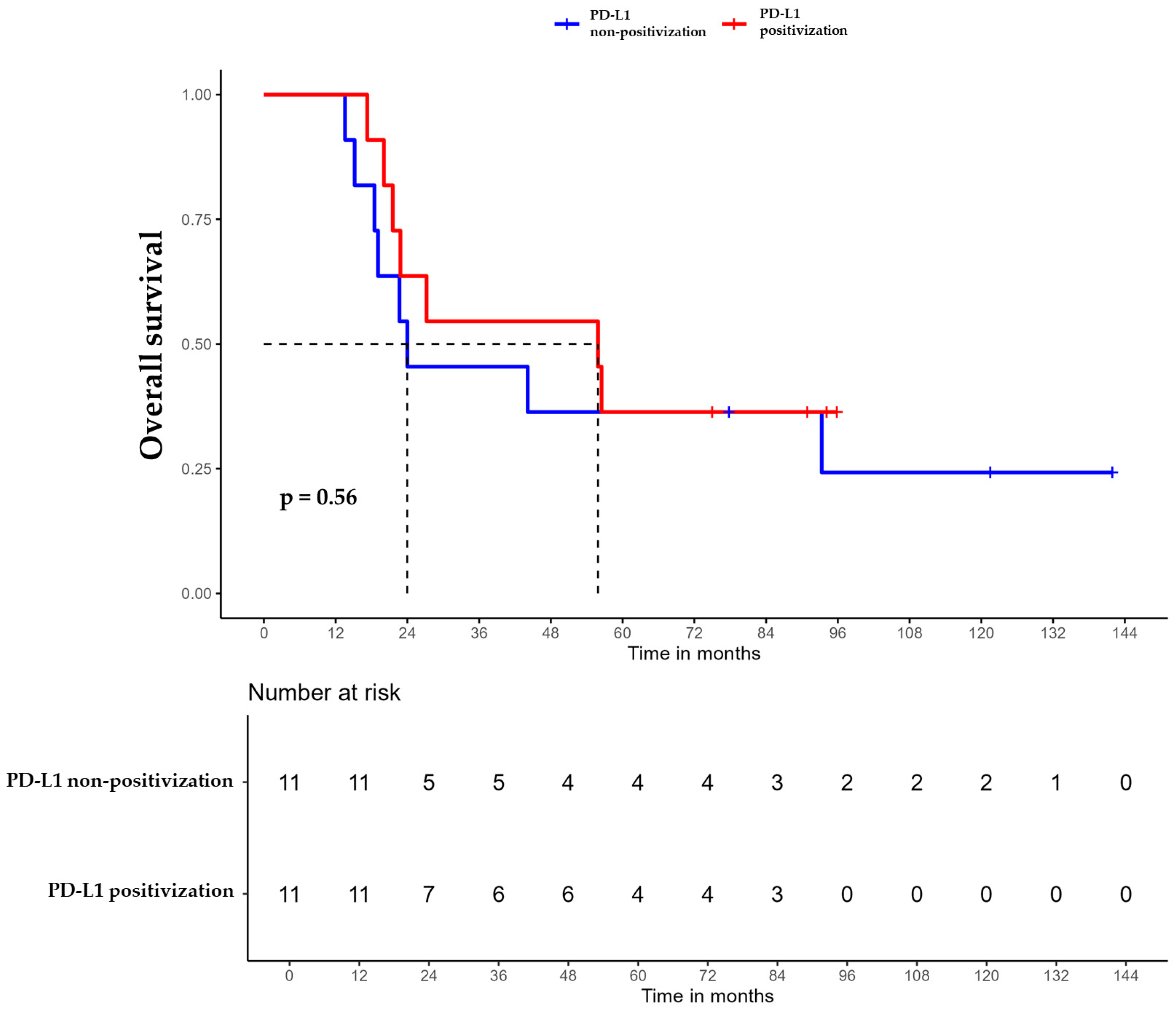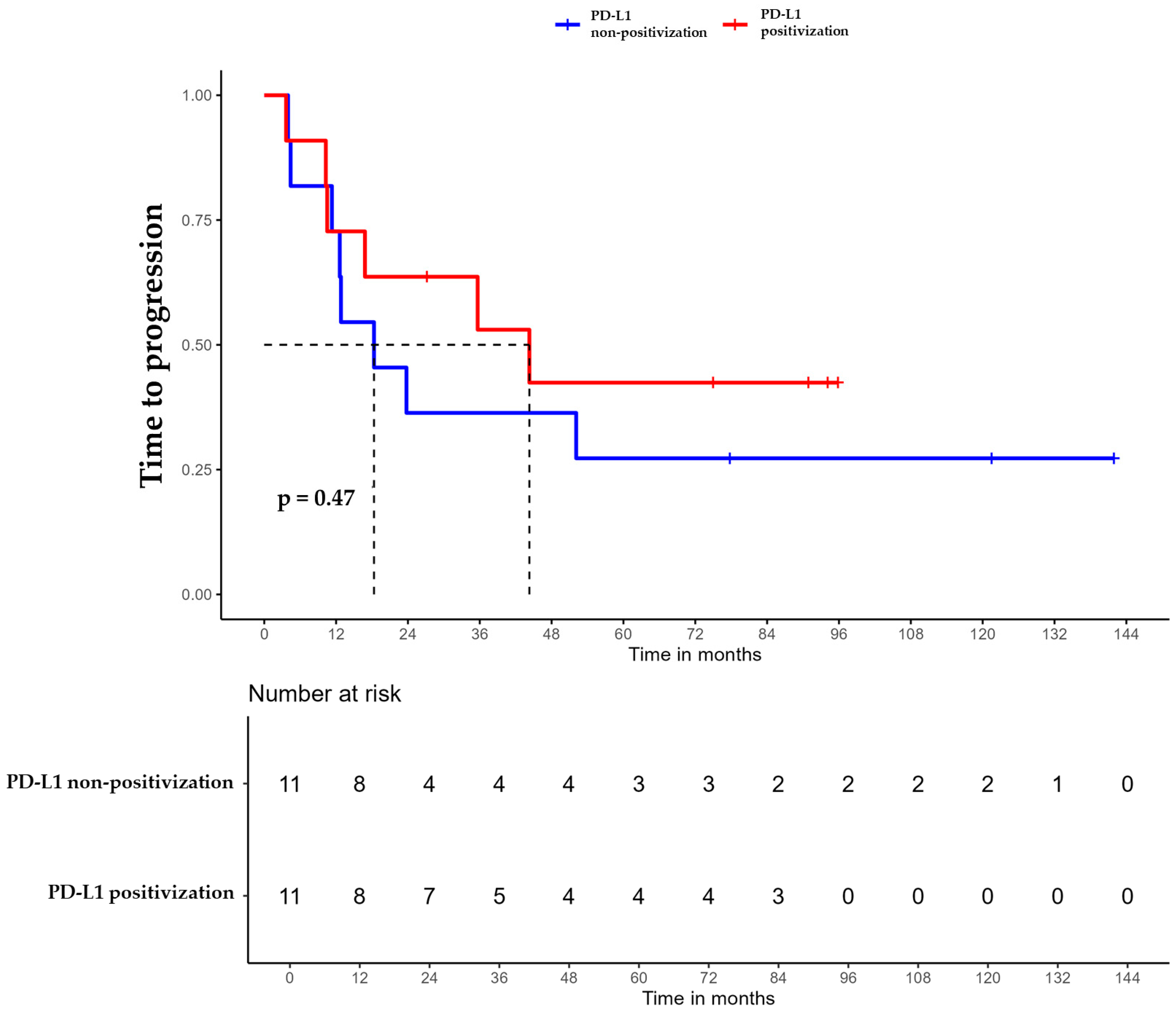Breast Cancer Stem Cells and Immunogenicity Profile in High-Risk Early Triple-Negative Breast Cancer: A Pilot Study
Abstract
1. Introduction
2. Results
2.1. Clinicopathological Characteristics
2.2. Basal Expression of BCSCs and Immunogenic Biomarkers
2.3. Effect of CT on BCSCs and Immunogenic Biomarkers
2.4. Effect of PD-L1 Positivization on Clinical Outcomes
3. Discussion
4. Materials and Methods
4.1. Study Design
4.2. Immunohistochemistry (IHC) Assay of Paired Tumor Samples
4.3. Statistical Analysis
5. Conclusions
Supplementary Materials
Author Contributions
Funding
Institutional Review Board Statement
Informed Consent Statement
Data Availability Statement
Acknowledgments
Conflicts of Interest
Abbreviations
| ALDH1 | Aldehyde dehydrogenase 1 enzyme |
| BCSC | Breast cancer stem cell |
| CT | Chemotherapy |
| DFS | Disease-free survival |
| EMT | Epithelial-mesenchymal transition |
| FFPE | Formalin-fixed paraffin-embedded |
| HER2 | Human epidermal growth factor receptor 2 |
| ICI | Immune checkpoint inhibitor |
| INF-γ | Interferon-γ |
| IDIBGI | Girona Biomedical Research Institute |
| IHC | Immunohistochemistry |
| NA | Not achieved |
| OS | Overall survival |
| pCR | Pathological complete response |
| PD-L1 | Programmed death-ligand 1 |
| TIL | Tumor-infiltrating lymphocyte |
| TNBC | Triple-negative breast cancer |
| TTP | Time to progression |
References
- Sung, H.; Ferlay, J.; Siegel, R.L.; Laversanne, M.; Soerjomataram, I.; Jemal, A.; Bray, F. Global Cancer Statistics 2020: GLOBOCAN Estimates of Incidence and Mortality Worldwide for 36 Cancers in 185 Countries. CA A Cancer J. Clin. 2021, 71, 209–249. [Google Scholar] [CrossRef]
- Baranova, A.; Krasnoselskyi, M.; Starikov, V.; Kartashov, S.; Zhulkevych, I.; Vlasenko, V.; Oleshko, K.; Bilodid, O.; Sadchikova, M.; Vinnyk, Y. Triple-Negative Breast Cancer: Current Treatment Strategies and Factors of Negative Prognosis. J. Med. Life 2022, 15, 153–161. [Google Scholar] [CrossRef] [PubMed]
- Chapdelaine, A.G.; Sun, G. Challenges and Opportunities in Developing Targeted Therapies for Triple Negative Breast Cancer. Biomolecules 2023, 13, 1207. [Google Scholar] [CrossRef] [PubMed]
- Saha, T.; Lukong, K.E. Breast Cancer Stem-Like Cells in Drug Resistance: A Review of Mechanisms and Novel Therapeutic Strategies to Overcome Drug Resistance. Front. Oncol. 2022, 12, 856974. [Google Scholar] [CrossRef]
- Gooding, A.J.; Schiemann, W.P. Epithelial-Mesenchymal Transition Programs and Cancer Stem Cell Phenotypes: Mediators of Breast Cancer Therapy Resistance. Mol. Cancer Res. 2020, 18, 1257–1270. [Google Scholar] [CrossRef] [PubMed]
- Varisli, L.; Zoumpourlis, P.; Spandidos, D.A.; Zoumpourlis, V.; Vlahopoulos, S. ALDH1A1 in Breast Cancer: A Prospective Target to Overcome Therapy Resistance (Review). Oncol. Lett. 2025, 29, 213. [Google Scholar] [CrossRef]
- Zhang, L.; Chen, W.; Liu, S.; Chen, C. Targeting Breast Cancer Stem Cells. Int. J. Biol. Sci. 2023, 19, 552–570. [Google Scholar] [CrossRef]
- Yao, J.; Li, S.; Wang, X. Identification of Breast Cancer Immune Subtypes by Analyzing Bulk Tumor and Single Cell Transcriptomes. Front. Cell Dev. Biol. 2022, 9, 781848. [Google Scholar] [CrossRef]
- Yi, H.; Li, Y.; Tan, Y.; Fu, S.; Tang, F.; Deng, X. Immune Checkpoint Inhibition for Triple-Negative Breast Cancer: Current Landscape and Future Perspectives. Front. Oncol. 2021, 11, 648139. [Google Scholar] [CrossRef]
- Schmid, P.; Cortes, J.; Pusztai, L.; McArthur, H.; Kümmel, S.; Bergh, J.; Denkert, C.; Park, Y.H.; Hui, R.; Harbeck, N.; et al. Pembrolizumab for Early Triple-Negative Breast Cancer. N. Engl. J. Med. 2020, 382, 810–821. [Google Scholar] [CrossRef]
- Cortes, J.; Rugo, H.S.; Cescon, D.W.; Im, S.A.; Yusof, M.M.; Gallardo, C.; Lipatov, O.; Barrios, C.H.; Perez-Garcia, J.; Iwata, H.; et al. Pembrolizumab plus Chemotherapy in Advanced Triple-Negative Breast Cancer. N. Engl. J. Med. 2022, 387, 217–226. [Google Scholar] [CrossRef] [PubMed]
- Schmid, P.; Adams, S.; Rugo, H.S.; Schneeweiss, A.; Barrios, C.H.; Iwata, H.; Diéras, V.; Hegg, R.; Im, S.A.; Shaw Wright, G.; et al. Atezolizumab and Nab-Paclitaxel in Advanced Triple-Negative Breast Cancer. N. Engl. J. Med. 2018, 379, 2108–2121. [Google Scholar] [CrossRef]
- Syamsu, S.A.; Faruk, M.; Smaradania, N.; Sampepajung, E.; Pranoto, A.S.; Irsandy, F.; Tammasse, I.F.U. PD-1/PD-L1 Pathway: Current Research in Breast Cancer. Breast Dis. 2024, 43, 79–92. [Google Scholar] [CrossRef] [PubMed]
- Salgado, R.; Denkert, C.; Demaria, S.; Sirtaine, N.; Klauschen, F.; Pruneri, G.; Wienert, S.; Van den Eynden, G.; Baehner, F.L.; Penault-Llorca, F.; et al. The Evaluation of Tumor-Infiltrating Lymphocytes (TILs) in Breast Cancer: Recommendations by an International TILs Working Group 2014. Ann. Oncol. 2015, 26, 259–271. [Google Scholar] [CrossRef] [PubMed]
- Brown, L.C.; Salgado, R.; Luen, S.J.; Savas, P.; Loi, S. Tumor-Infiltrating Lymphocyctes in Triple-Negative Breast Cancer: Update for 2020. Cancer J. 2021, 27, 25–31. [Google Scholar] [CrossRef]
- Cortazar, P.; Zhang, L.; Untch, M.; Mehta, K.; Costantino, J.P.; Wolmark, N.; Bonnefoi, H.; Cameron, D.; Gianni, L.; Valagussa, P.; et al. Pathological Complete Response and Long-Term Clinical Benefit in Breast Cancer: The CTNeoBC Pooled Analysis. Lancet 2014, 384, 164–172. [Google Scholar] [CrossRef]
- Ordaz-Ramos, A.; Tellez-Jimenez, O.; Vazquez-Santillan, K. Signaling Pathways Governing the Maintenance of Breast Cancer Stem Cells and Their Therapeutic Implications. Front. Cell Dev. Biol. 2023, 11, 1221175. [Google Scholar] [CrossRef] [PubMed]
- Cao, L.; Sun, P.L.; Yao, M.; Jia, M.; Gao, H. Expression of YES-Associated Protein (YAP) and Its Clinical Significance in Breast Cancer Tissues. Hum. Pathol. 2017, 68, 166–174. [Google Scholar] [CrossRef]
- Panigoro, S.S.; Kurnia, D.; Kurnia, A.; Haryono, S.J.; Albar, Z.A. ALDH1 Cancer Stem Cell Marker as a Prognostic Factor in Triple-Negative Breast Cancer. Int. J. Surg. Oncol. 2020, 2020, 7863243. [Google Scholar] [CrossRef]
- Resetkova, E.; Reis-Filho, J.S.; Jain, R.K.; Mehta, R.; Thorat, M.A.; Nakshatri, H.; Badve, S. Prognostic Impact of ALDH1 in Breast Cancer: A Story of Stem Cells and Tumor Microenvironment. Breast Cancer Res. Treat. 2010, 123, 97–108. [Google Scholar] [CrossRef]
- Lee, A.; Won, K.Y.; Lim, S.J.; Cho, S.Y.; Han, S.A.; Park, S.G.; Song, J.Y. ALDH1 and Tumor Infiltrating Lymphocytes as Predictors for Neoadjuvant Chemotherapy Response in Breast Cancer. Pathol. Res. Pract. 2018, 214, 619–624. [Google Scholar] [CrossRef] [PubMed]
- Liu, Y.; Hu, Y.; Xue, J.; Li, J.; Yi, J.; Bu, J.; Zhang, Z.; Qiu, P.; Gu, X. Advances in Immunotherapy for Triple-Negative Breast Cancer. Mol. Cancer 2023, 22, 145. [Google Scholar] [CrossRef]
- Grandal, B.; Mangiardi-veltin, M.; Laas, E.; Laé, M.; Meseure, D.; Bataillon, G.; El-alam, E.; Darrigues, L.; Dumas, E.; Daoud, E.; et al. PD-L1 Expression after Neoadjuvant Chemotherapy in Triple-Negative Breast Cancers Is Associated with Aggressive Residual Disease, Suggesting a Potential for Immunotherapy. Cancers 2021, 13, 746. [Google Scholar] [CrossRef]
- Hanamura, T.; Kitano, S.; Kagamu, H.; Yamashita, M.; Terao, M.; Tsuda, B.; Okamura, T.; Kumaki, N.; Hozumi, K.; Harada, N.; et al. Immunological Profiles of the Breast Cancer Microenvironment Represented by Tumor-Infiltrating Lymphocytes and PD-L1 Expression. Sci. Rep. 2022, 12, 8098. [Google Scholar] [CrossRef]
- Danziger, N.; Sokol, E.S.; Graf, R.P.; Hiemenz, M.C.; Maule, J.; Parimi, V.; Palmieri, C.; Pusztai, L.; Ross, J.S.; Huang, R.S. Variable Landscape of PD-L1 Expression in Breast Carcinoma as Detected by the DAKO 22C3 Immunohistochemistry Assay. Oncologist 2023, 28, 319–326. [Google Scholar] [CrossRef]
- Angelico, G.; Broggi, G.; Tinnirello, G.; Puzzo, L.; Vecchio, G.M.; Salvatorelli, L.; Memeo, L.; Santoro, A.; Farina, J.; Mulé, A.; et al. Tumor Infiltrating Lymphocytes (TILS) and PD-L1 Expression in Breast Cancer: A Review of Current Evidence and Prognostic Implications from Pathologist’s Perspective. Cancers 2023, 15, 4479. [Google Scholar] [CrossRef]
- Lopez, M.L.G.; Gebo, A.; Parodi, M.; Persano, S.; Maus-Conn, J.; Mingari, M.C.; Loiacono, F.; Orecchia, P.; Sivori, S.; Cantoni, C.; et al. CD56bright Cytokine-Induced Memory-like NK Cells and NK-Cell Engagers Synergize against Non-Small Cell Lung Cancer Cancer-Stem Cells. J. Immunother. Cancer 2025, 13, e010205. [Google Scholar] [CrossRef] [PubMed]
- Almozyan, S.; Colak, D.; Mansour, F.; Alaiya, A.; Al-Harazi, O.; Qattan, A.; Al-Mohanna, F.; Al-Alwan, M.; Ghebeh, H. PD-L1 Promotes OCT4 and Nanog Expression in Breast Cancer Stem Cells by Sustaining PI3K/AKT Pathway Activation. Int. J. Cancer 2017, 141, 1402–1412. [Google Scholar] [CrossRef] [PubMed]
- AiErken, N.J.; Shi, H.J.; Zhou, Y.; Shao, N.; Zhang, J.; Shi, Y.; Yuan, Z.Y.; Lin, Y. High PD-L1 Expression Is Closely Associated with Tumor-Infiltrating Lymphocytes and Leads to Good Clinical Outcomes in Chinese Triple Negative Breast Cancer Patients. Int. J. Biol. Sci. 2017, 13, 1172–1179. [Google Scholar] [CrossRef]
- Muenst, S.; Schaerli, A.R.; Gao, F.; Däster, S.; Trella, E.; Droeser, R.A.; Muraro, M.G.; Zajac, P.; Zanetti, R.; Gillanders, W.E.; et al. Expression of Programmed Death Ligand 1 (PD-L1) Is Associated with Poor Prognosis in Human Breast Cancer. Breast Cancer Res. Treat. 2014, 146, 15–24. [Google Scholar] [CrossRef]





| Variables | Results | |
|---|---|---|
| Age, mean (range) [median] years | 51 (31–81) [47] | |
| Breast cancer histology, n (%) | Invasive ductal carcinoma | 23 (79.3) |
| Invasive lobular carcinoma | 1 (3.4) | |
| Metaplastic carcinoma | 3 (10.3) | |
| Others | 2 (6.9) | |
| Histology grade, n (%) | I | 0 (0) |
| II | 4 (13.8) | |
| III | 22 (75.9) | |
| Unknown | 3 (10.3) | |
| Estrogen receptor, n (%) | 0% | 28 (96.6) |
| 1–10% | 1 (3.4) | |
| Progesterone receptor, n (%) | 0% | 29 (100) |
| p53 expression, n (%) | 0 | 5 (17.2) |
| <25% | 3 (10.3) | |
| >75% | 5 (17.2) | |
| 100% | 1 (3.4) | |
| Unknown | 15 (51.7) | |
| Ki-67 index, mean (SD) (%) | 57.5 (30.7) | |
| Cadherin expression, n (%) | Partially positive | 1 (3.4) |
| Positive | 26 (89.7) | |
| Unknown | 2 (6.9) | |
| CK 5/6 expression, n (%) | Negative | 1 (3.4) |
| <10% | 3 (10.3) | |
| 11–25% | 2 (6.9) | |
| Unknown | 23 (79.3) | |
| HER2 expression, n (%) | 0 | 14 (48.3) |
| 1+ | 9 (31.0) | |
| 2+ | 5 (17.2) | |
| Unknown | 1 (3.4) | |
| Breast cancer stage group (TNM 1), n (%) | IA | 1 (3.4) |
| IIA | 5 (17.2) | |
| IIB | 10 (34.5) | |
| IIIA | 6 (20.7) | |
| IIIB | 4 (13.8) | |
| IIIC | 3 (10.3) | |
| Tumor size, mean (SD) mm | 26.02 (26) | |
| Nodal involvement, n (%) | N0 | 11 (37.9) |
| N1 | 12 (41.4) | |
| N2 | 3 (10.3) | |
| N3 | 3 (10.3) | |
| Surgery type, n (%) | Breast conservative surgery | 19 (65.5) |
| Mastectomy | 10 (34.5) | |
| Chemotherapy regimen, n (%) | Anthracyclines | 2 (6.9) |
| Anthracyclines and taxanes | 23 (79.4) | |
| CMF | 1 (3.4) | |
| Others (clinical trial) | 2 (6.9) | |
| None | 1 (3.4) | |
| Chemotherapy type, n (%) | Neoadjuvant | 25 (86.2) |
| Adjuvant | 4 (13.8) | |
| Radiotherapy, n (%) | Yes | 22 (75.9) |
| No | 7 (24.1) | |
| Vital status, n (%) | Alive | 14 (48.3) |
| Deceased | 15 (51.7) | |
| Relapse, n (%) | Yes | 13 (44.8) |
| No | 16 (55.2) | |
| Relapse localization, n (%) | Visceral | 12 (92.3) |
| Non-visceral | 1 (7.7) | |
| BRCA germinal status, n (%) | Mutated | 4 (13.8) |
| Non-mutated | 15 (51.7) | |
| Unknown | 10 (34.5) | |
| Biomarker | Expression Evaluation | ||
|---|---|---|---|
| BCSCs | CD44, CD24 and ALDH1 | 0 | Total absence |
| 1+ | Mild | ||
| 2+ | Moderate | ||
| 3+ | Intense | ||
| Immunogenicity | PD-L1 | <1% | Negative |
| ≥1% | Positive | ||
| TILs | According to International TILs Working Group 2014 [14] | ||
Disclaimer/Publisher’s Note: The statements, opinions and data contained in all publications are solely those of the individual author(s) and contributor(s) and not of MDPI and/or the editor(s). MDPI and/or the editor(s) disclaim responsibility for any injury to people or property resulting from any ideas, methods, instructions or products referred to in the content. |
© 2025 by the authors. Licensee MDPI, Basel, Switzerland. This article is an open access article distributed under the terms and conditions of the Creative Commons Attribution (CC BY) license (https://creativecommons.org/licenses/by/4.0/).
Share and Cite
Roqué-Lloveras, A.; Pérez-Bueno, F.; Pozo-Ariza, X.; Polonio-Alcalá, E.; Ausellé-Bosch, S.; Oliveras, G.; Viñas, G.; Puig, T. Breast Cancer Stem Cells and Immunogenicity Profile in High-Risk Early Triple-Negative Breast Cancer: A Pilot Study. Int. J. Mol. Sci. 2025, 26, 3960. https://doi.org/10.3390/ijms26093960
Roqué-Lloveras A, Pérez-Bueno F, Pozo-Ariza X, Polonio-Alcalá E, Ausellé-Bosch S, Oliveras G, Viñas G, Puig T. Breast Cancer Stem Cells and Immunogenicity Profile in High-Risk Early Triple-Negative Breast Cancer: A Pilot Study. International Journal of Molecular Sciences. 2025; 26(9):3960. https://doi.org/10.3390/ijms26093960
Chicago/Turabian StyleRoqué-Lloveras, Ariadna, Ferran Pérez-Bueno, Xavier Pozo-Ariza, Emma Polonio-Alcalá, Sira Ausellé-Bosch, Glòria Oliveras, Gemma Viñas, and Teresa Puig. 2025. "Breast Cancer Stem Cells and Immunogenicity Profile in High-Risk Early Triple-Negative Breast Cancer: A Pilot Study" International Journal of Molecular Sciences 26, no. 9: 3960. https://doi.org/10.3390/ijms26093960
APA StyleRoqué-Lloveras, A., Pérez-Bueno, F., Pozo-Ariza, X., Polonio-Alcalá, E., Ausellé-Bosch, S., Oliveras, G., Viñas, G., & Puig, T. (2025). Breast Cancer Stem Cells and Immunogenicity Profile in High-Risk Early Triple-Negative Breast Cancer: A Pilot Study. International Journal of Molecular Sciences, 26(9), 3960. https://doi.org/10.3390/ijms26093960







